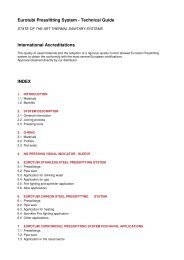corrosion of stainless steel - Damstahl
corrosion of stainless steel - Damstahl
corrosion of stainless steel - Damstahl
You also want an ePaper? Increase the reach of your titles
YUMPU automatically turns print PDFs into web optimized ePapers that Google loves.
Chapter 6 - Corrosion <strong>of</strong> Stainless Steel<br />
6.2.7 Flying Rust<br />
Everyone with a dishwasher knows the problem: The knives get rusty while<br />
forks and spoons usually don't get tainted at all. On top <strong>of</strong> this, it is not the<br />
whole knife that gets rusty; usually only the blade looks bad, and when you<br />
ask the local shop, you are told that this is 'flying rust' from the dishwasher's<br />
white-painted mesh.<br />
Figure 6.15:<br />
Pitting <strong>corrosion</strong> on <strong>stainless</strong> <strong>steel</strong> knife blades (<strong>steel</strong> type 4021, 13.5% Cr).<br />
The <strong>corrosion</strong> has arisen during the dishwashing process, the so-called<br />
'flying rust', due to the fact that the PREN <strong>of</strong> the knife blade is too poor.<br />
The picture on the right is a microscope photo <strong>of</strong> the cutting edge <strong>of</strong> the<br />
same knife blade.<br />
Martensitic knife<br />
blades are <strong>of</strong>ten<br />
attacked by pitting<br />
<strong>corrosion</strong> = '<br />
flying rust'<br />
Nonsense. Had the rust stains been caused by particles from the mesh, all<br />
knives, forks, spoons, plates and glass would be stained, but it is always<br />
only the knife blades. The cause is to be found in Table 6.1 which shows<br />
that all martensitic <strong>steel</strong> qualities have a quite poor resistance towards<br />
pitting <strong>corrosion</strong>. Most martensites have a PREN <strong>of</strong> between 12 and 15, and<br />
this makes them significantly less resistant to pitting <strong>corrosion</strong> than 4301<br />
(PREN 17.5). The knife blades are simply less resistant to pitting <strong>corrosion</strong>,<br />
however, as adding more Cr or Mo to the <strong>steel</strong> is not possible as this will<br />
affect the hardening <strong>of</strong> the blades. Instead, the solution is to ensure a short<br />
contact time which is easily done with short washing cycles or (even better)<br />
washing by hand.<br />
Should your knives, despite all precautions, suffer from 'flying rust', the best<br />
way to remove the rust stains is to use hot citric acid (see Section 12.3.2 on<br />
page 263). This removes the rust stains, but <strong>of</strong> course not the small micro pits<br />
created by the <strong>corrosion</strong> which is why the best solution is always to prevent<br />
<strong>corrosion</strong> attack by using mild washing methods. Lower temperature and/<br />
or shorter time are a couple <strong>of</strong> good steps in the right direction.<br />
97<br />
RS for alle.indb 97<br />
9/29/2011 12:44:39 PM

















